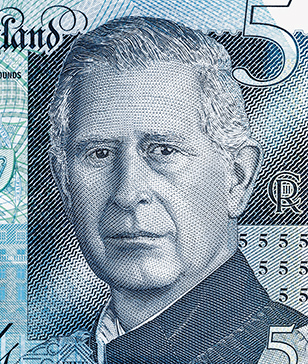1956
The Bank of England is allowed to use HM Queen Elizabeth II's portrait
In 1956, the UK Treasury gave permission to the Bank of England to use HM Queen Elizabeth II’s portrait in a new series of notes.
The Bank of England warned the public that ‘notes incorporating these designs are unlikely to be issued for several years to come.’
1960–1961
HM Queen Elizabeth II first appears on a Bank of England note
The first Bank of England note to feature HM Queen Elizabeth II’s portrait was the £1 note issued in 1960. It was followed by a ten shilling note in 1961.
Both notes use the same portrait by banknote designer Robert Austin. HM Queen Elizabeth II is wearing the Diamond Diadem, notable for featuring on many other banknotes and stamps. It was a formal, regal image, and was criticised for being a severe and unrealistic likeness.
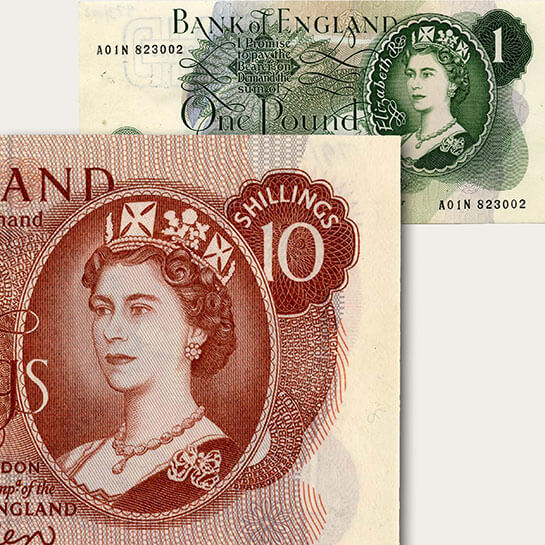
1961
Test prints for HM Queen Elizabeth II's portrait
In the early 1960s, banknote designer Reynolds Stone worked on a new portrait for the £5 and £10 notes which would complete the ‘C’ series of banknotes. These are test prints for different versions of the portrait. The version on the right is closest to the final image that appeared on the notes.
1963–1964
Series C £5 and £10 notes
A new £5 was issued in 1963 and a new £10 in 1964. Both featured a new portrait by Reynolds Stone.
This new portrait had a better reception than Austin’s version. People thought the portrait was more realistic and her gaze was more relaxed.
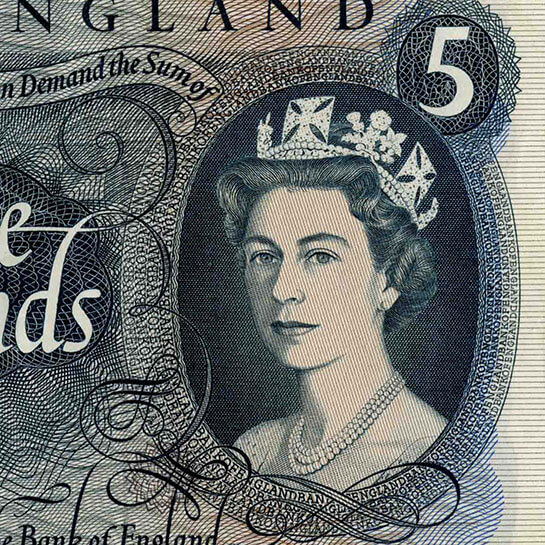
1967
An unissued 50p note
In the late 1960s, the Bank of England proposed a new 10 shilling note as the first in a new series. The portrait showed HM Queen Elizabeth II wearing the hat and robes of the Order of the Garter.
It soon became clear that the British currency would change from pounds, shillings and pence to the decimal system of 100 pennies in the pound. So designers changed the denomination to its equivalent decimal value, 50 pence.
Instead, a 50p coin was created as part of the new system of decimal coinage. Ten shilling notes were withdrawn in 1970, and the 50p note was never issued.
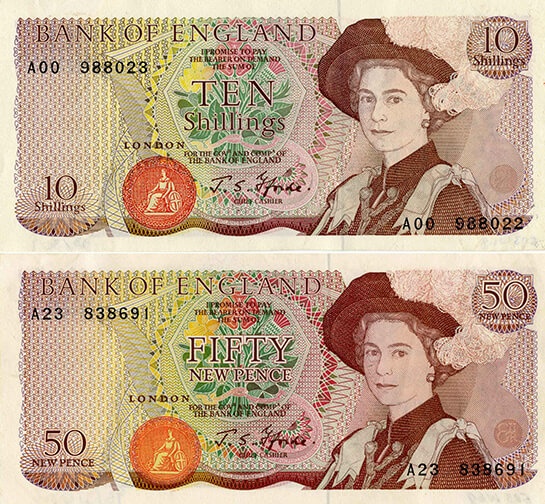
1970s
New portraits for D Series notes
The series of notes issued in the 1970s featured two different portraits of HM Queen Elizabeth II. One version was used for £1 and £5 notes, and another for the ‘high sum’ notes of £10, £20 and £50.
This new series of banknotes was the first to feature historical characters on the back. In both portraits, HM Queen Elizabeth II is wearing elaborate ceremonial dress. This emphasises a sense of formality and tradition.
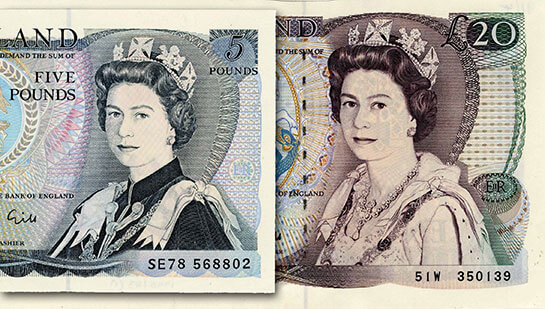
1970
A new portrait for 'high sum' notes
This is the master drawing created by designer Harry Eccleston for the portrait that appeared on the £10 issued in 1975, the £20 issued in 1970 and the £50 issued in 1981.
As well as the Diamond Diadem, HM Queen Elizabeth II is shown wearing her State Robes and collar of the Order of the Garter. These are part of her ceremonial clothes usually worn for the State Opening of Parliament.
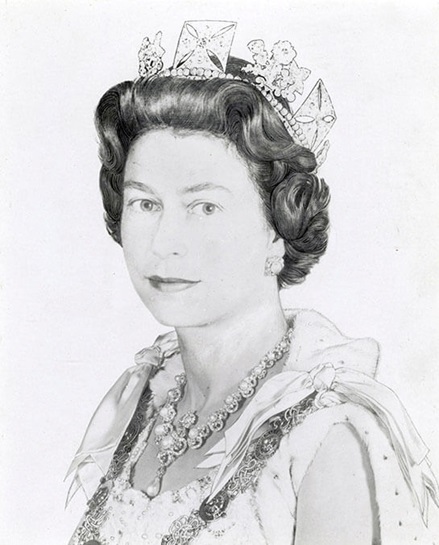
1971
A second portrait for the £5 and £1 notes
In the second version of the portrait, HM Queen Elizabeth II is wearing the dark blue robes of the Order of the Garter, one of the highest orders in the British honours system. This was used on the £5 issued in 1971 and the £1 issued in 1978.
These large, detailed master drawings were photographically shrunk down. They were then used to create a much smaller engraved image for the banknote.
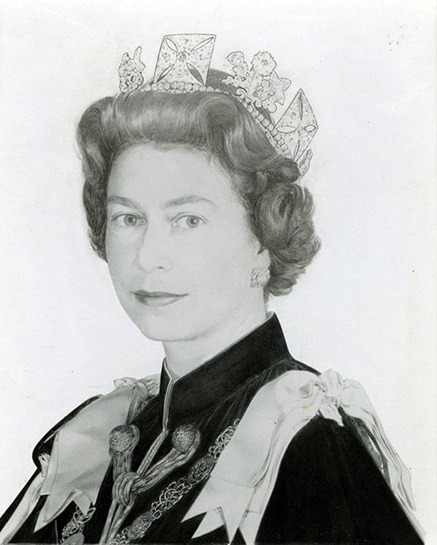
1990
A timeless image for E Series
The 1990 £5 note was the first of a new series. It featured a new, more mature portrait of HM Queen Elizabeth II who was 64 when it was first issued.
This likeness, by designer Roger Withington, has been used on all Bank of England notes since. It has become a familiar image, which makes it a useful anti-counterfeiting feature. People can detect changes in pictures of faces, especially well-known ones, much more easily than in other types of pattern. That helps people detect counterfeits with badly copied images.
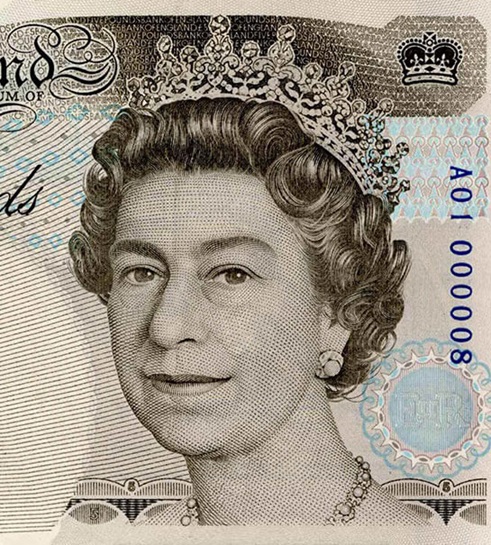
1990
Design for the watermark portrait
Since the 1990s, the watermark on paper banknotes has been based on a second portrait of HM Queen Elizabeth II by Roger Withington.
It’s a simpler image without elaborate jewellery because the watermark is smaller and less detailed than the main portrait.
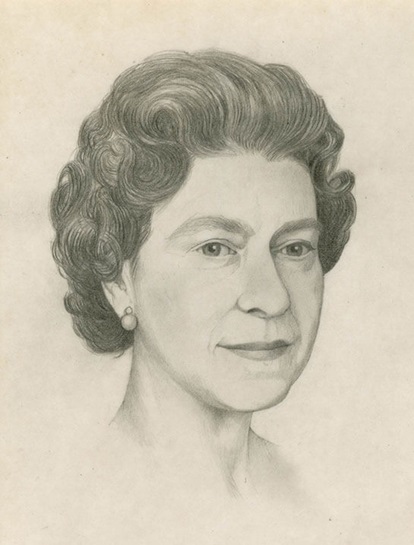
Since 1990
Creating a watermark
To create the watermark design, designers produce a 3D, metal version of the image called a die (pictured on the left). This is used to impress the design onto wire mesh (pictured centre). The mesh is used to impress a design in the banknote paper, seen here on the £20 first issued in 2007 (pictured right).
The result is a simplified version of the original portrait but it is still recognisable.

Since 2016
Portraits on polymer
Today’s notes use the same portrait of HM Queen Elizabeth II that has appeared since 1990. Instead of a watermark, they feature a see-through window containing a smaller but clearly-defined version of the portrait.
The familiarity of this portrait helped create a sense of continuity when the Bank of England began printing notes on polymer in 2016. It’s a timeless image of a monarch who has been a feature of our banknotes for generations.
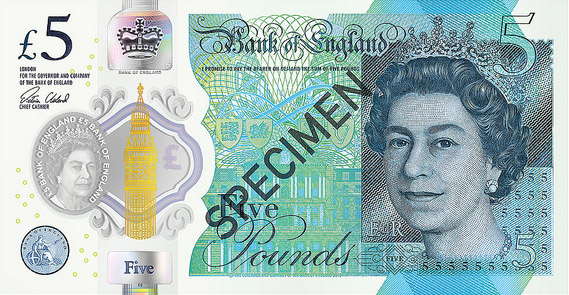
2024
Following the passing of Queen Elizabeth II in September 2022, the Bank of England began producing banknotes featuring a portrait of HM King Charles III. The note will enter circulation on 5 June 2024 and will co-circulate with banknotes featuring Queen Elizabeth II.